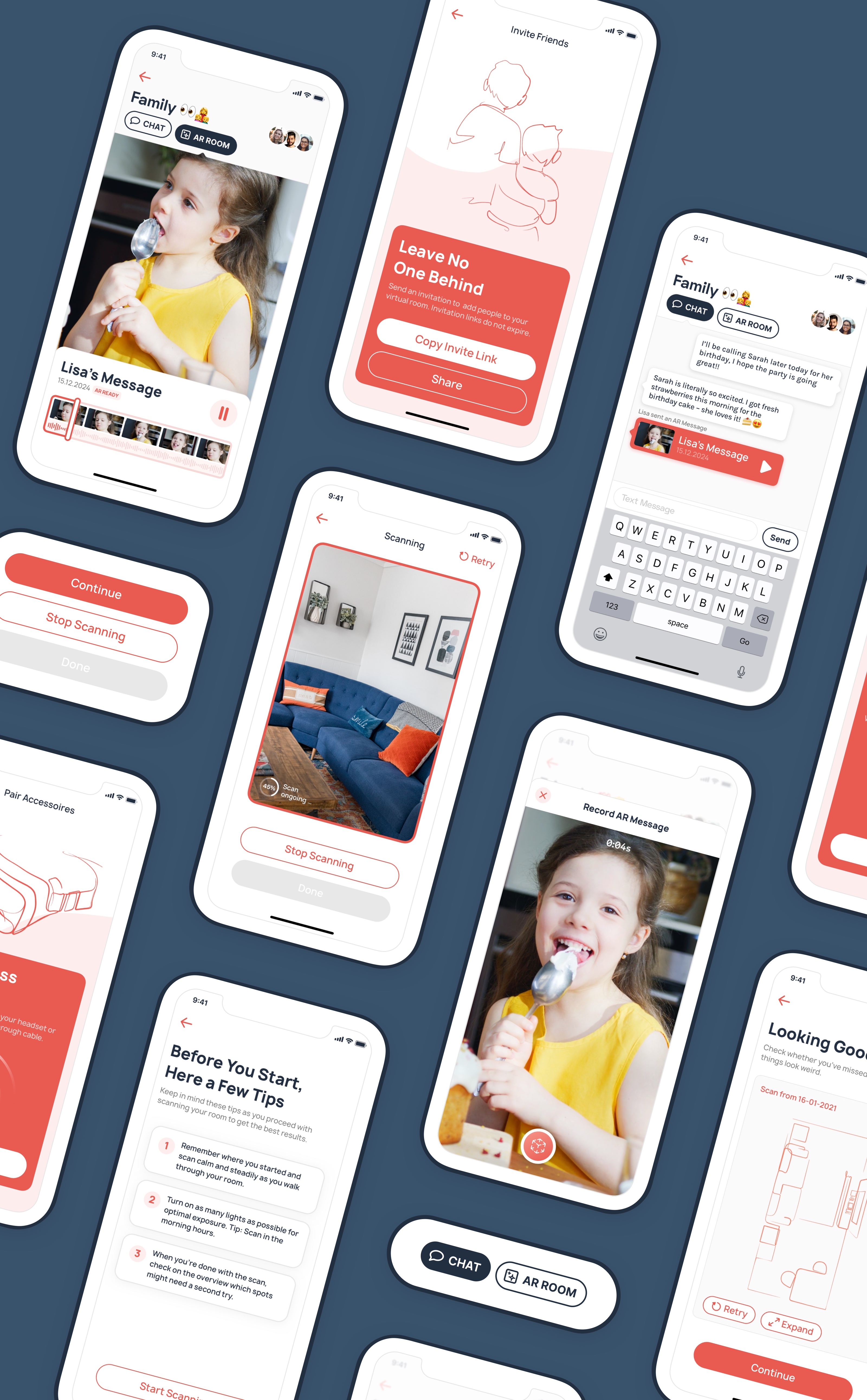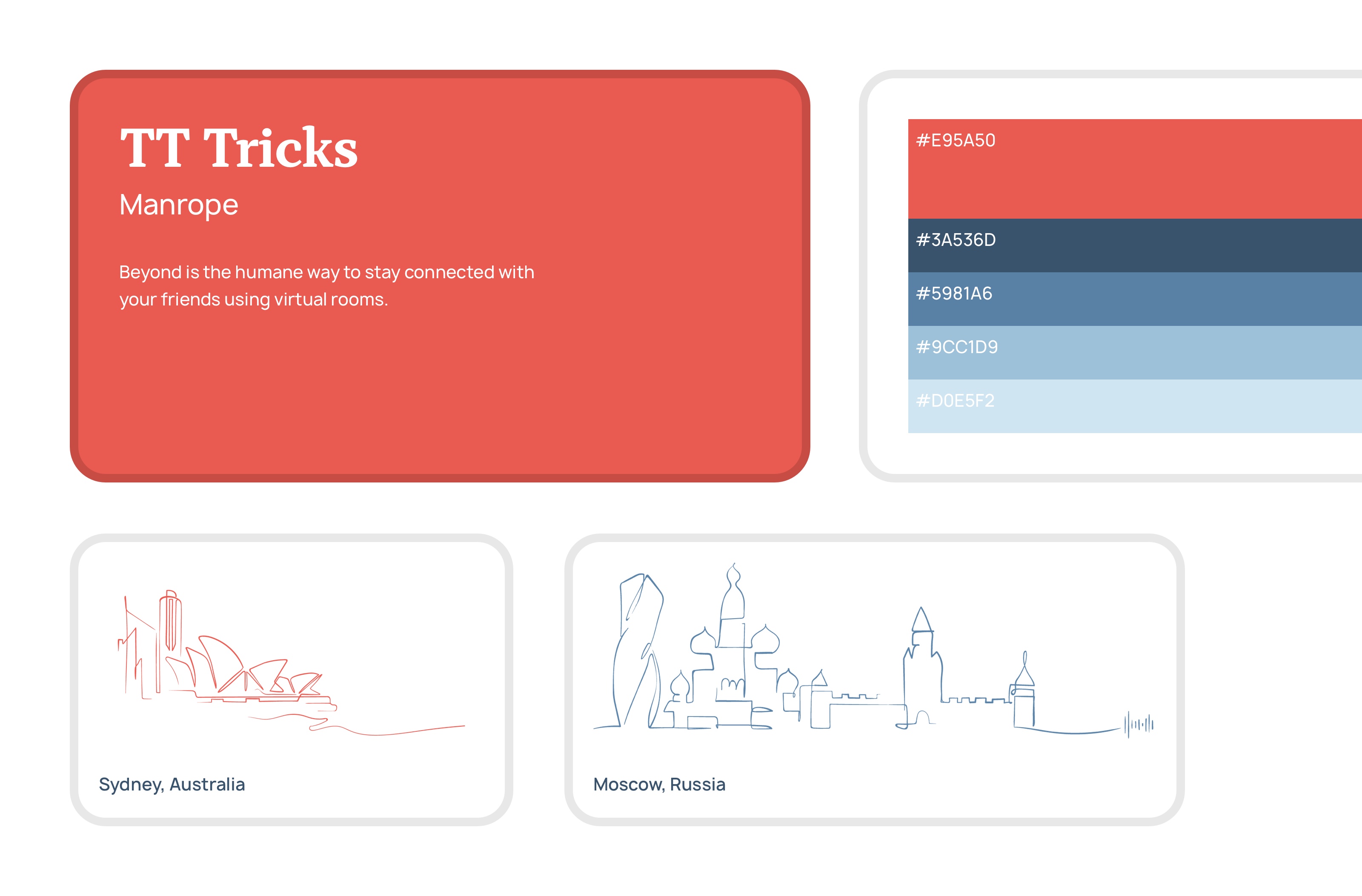Beyond — Immersive Messaging
Hochschule für Gestaltung Schwäbisch Gmünd — 2020-2021 · Concept, Digital Design
Introduction
Context and Role
This project was designed as part of the second semester of the Strategic Design Master Degree. The brief of this semesters project was to design something that's more speculative and critical, contrasting to the way designers would would make product decisions otherwise. We were given a briefing to work within the claim of "Seeing Beyond" and worked with various design futuring methods.
Together with my project partner Carina Kraus I walked through the methodology and process. Later in the semester, we split up into our professions: Carina worked out the branding and illustrations as well as a brand narrative. I was in charge of the product design and user experience as well as the web design in form of a landing page. Additionally, I created a short video to frame our storytelling and to kickoff our final pitch presentation.
Asynchronous Communication. Realtime Communication. Augmented Reality. Virtual Reality. Interplanetary Travel. Immersive Experiences.
How will communication change in the future?
Design Futuring Methods
The tools designers use to work out products and services that create value mostly start by looking at the status quo and then progress from there. Speculative Design and Critical Design are design disciplines that turn this paradigm around: by using bolder hypothesis and (sometimes) far fetched future scenarios, speculative projects end up becoming artifacts of the future.
While the speculative nature can disconnect these projects from todays market or user needs, they are still useful to inform product development. We applied the methods of backcasting and design futuring by taking the speculative design project and backcasting the insights into a product that could exist today.
How can we design communication tools to counter social isolation and embrace healthy media consumption at the same time?
Rethinking Personal Communication: Beyond
We post pictures and videos, edit and filter like never before. But in the rarest cases we do this for the people we really care about. Between meaningless text messages, what is supposed to connect us gets lost: emotion. With Beyond we explore new ways of personal communication, far from endless timelines and recommendations. With the new technologies of augmented reality, Beyond creates an alternative concept through which personal conversations can become more immersive and humane in the future.
The product aims to make communication between personal contacts more intimate and immersive. Based on the research, we have defined several functions with which the degree of immersion can be gradually expanded using a roadmap. The functions are based on an app that places group conversations in virtual rooms instead of traditional chat rooms. Users can record messages of various types (voice memos, videos, text messages) and place them in the room.

Scenario and Persona Insights
The design of the personas was particularly decisive for the conception of the hardware feature and the low entry threshold in phase 1: Due to the particularly personal to intimate orientation of the product, the personas fall on the closest relationships of the users: relationships, close friendships and families. We were able to set up the following design motifs with the help of the personas:
1. Defining entire families as a target group implies that users with different technical skills must be able to understand and operate the service. The basic building blocks of the service's complexity must not exceed that of traditional messenger apps. The service offers different levels of complexity so that the service can be used by different groups of people.
2. Understanding the immersive functions should not be an exclusion criterion for participation in virtual rooms. The app and its functionality are structured in such a way that basic digital knowledge can already be used in the virtual rooms (e.g. via the chat function).
3. Building a network effect with an AR / VR product is a challenge due to the limited use of VR headsets (especially in middle to old age). In this situation, the use of such headsets in the app is optional. Each user can choose the appropriate level of immersion without having to completely forego the advantages of virtual rooms.


Notes
The work shown stems from a group project, so I tried to limit the work shown to the parts that I designed. For the full documentation and some background on our research visit the official HfG project entry
The team consisted of Carina Kraus and me. The project was supervised by Prof. Benedikt Gross (LinkedIn) and Eileen Mandir (LinkedIn).
↑ Go back up
Beyond — Immersive Messaging
Hochschule für Gestaltung Schwäbisch Gmünd — 2020-2021 · Concept, Digital Design
Introduction
This project was designed as part of the second semester of the Strategic Design Master Degree. The brief of this semesters project was to design something that's more speculative and critical, contrasting to the way designers would would make product decisions otherwise. We were given a briefing to work within the claim of "Seeing Beyond" and worked with various design futuring methods.
Context and Role
Together with my project partner Carina Kraus I walked through the methodology and process. Later in the semester, we split up into our professions: Carina worked out the branding and illustrations as well as a brand narrative. I was in charge of the product design and user experience as well as the web design in form of a landing page. Additionally, I created a short video to frame our storytelling and to kickoff our final pitch presentation.
Asynchronous Communication. Realtime Communication. Augmented Reality. Virtual Reality. Interplanetary Travel. Immersive Experiences.
How will communication change in the future?
Design Futuring Methods
The tools designers use to work out products and services that create value mostly start by looking at the status quo and then progress from there. Speculative Design and Critical Design are design disciplines that turn this paradigm around: by using bolder hypothesis and (sometimes) far fetched future scenarios, speculative projects end up becoming artifacts of the future.
While the speculative nature can disconnect these projects from todays market or user needs, they are still useful to inform product development. We applied the methods of backcasting and design futuring by taking the speculative design project and backcasting the insights into a product that could exist today.
How can we design communication tools to counter social isolation and embrace healthy media consumption at the same time?
Rethinking Personal Communication: Beyond
We post pictures and videos, edit and filter like never before. But in the rarest cases we do this for the people we really care about. Between meaningless text messages, what is supposed to connect us gets lost: emotion. With Beyond we explore new ways of personal communication, far from endless timelines and recommendations. With the new technologies of augmented reality, Beyond creates an alternative concept through which personal conversations can become more immersive and humane in the future.
The product aims to make communication between personal contacts more intimate and immersive. Based on the research, we have defined several functions with which the degree of immersion can be gradually expanded using a roadmap. The functions are based on an app that places group conversations in virtual rooms instead of traditional chat rooms. Users can record messages of various types (voice memos, videos, text messages) and place them in the room.

Scenario and Persona Insights
The design of the personas was particularly decisive for the conception of the hardware feature and the low entry threshold in phase 1: Due to the particularly personal to intimate orientation of the product, the personas fall on the closest relationships of the users: relationships, close friendships and families. We were able to set up the following design motifs with the help of the personas:
1. Defining entire families as a target group implies that users with different technical skills must be able to understand and operate the service. The basic building blocks of the service's complexity must not exceed that of traditional messenger apps. The service offers different levels of complexity so that the service can be used by different groups of people.
2. Understanding the immersive functions should not be an exclusion criterion for participation in virtual rooms. The app and its functionality are structured in such a way that basic digital knowledge can already be used in the virtual rooms (e.g. via the chat function).
3. Building a network effect with an AR / VR product is a challenge due to the limited use of VR headsets (especially in middle to old age). In this situation, the use of such headsets in the app is optional. Each user can choose the appropriate level of immersion without having to completely forego the advantages of virtual rooms.


Notes
The work shown stems from a group project, so I tried to limit the work shown to the parts that I designed. For the full documentation and some background on our research visit the official HfG project entry
The team consisted of Carina Kraus and me. The project was supervised by Prof. Benedikt Gross (LinkedIn) and Eileen Mandir (LinkedIn).
↑ Go back up